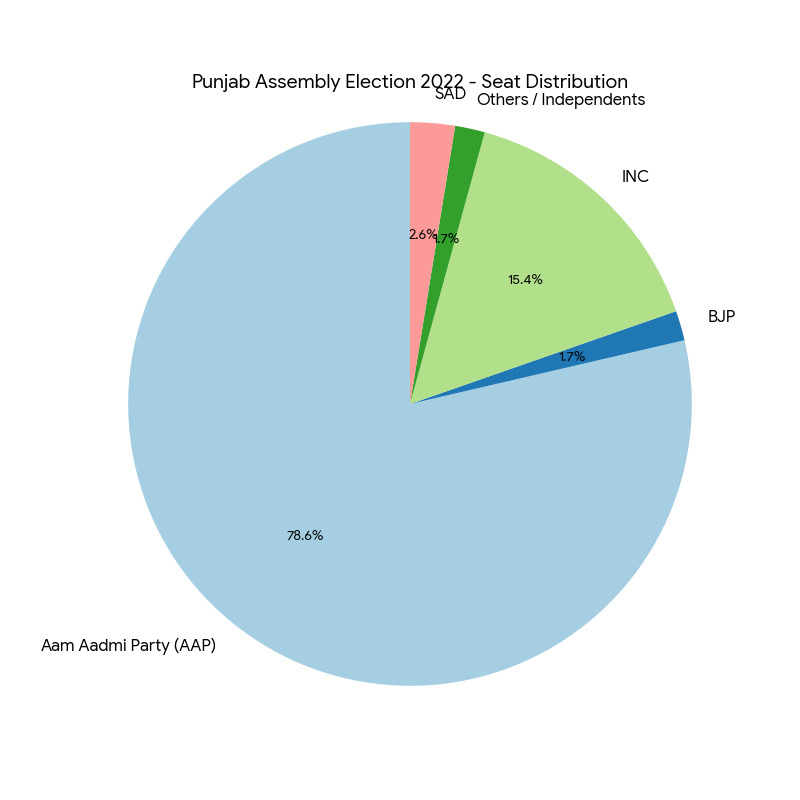Punjab Assembly Election
1952 Punjab Legislative Assembly Election Results
| 1952 Punjab Legislative Assembly Election Results | |||
|---|---|---|---|
| Sr. No. | Short Name | Full Name | Seats |
| 1 | INC | Indian National Congress | 96 |
| 2 | Zamindara Party | Zamindara Party | 4 |
| 3 | CPI | Communist Party Of India | 4 |
| 4 | Akali Dal | Akali Dal | 2 |
| 5 | Independents & Others | Independents & Others | 20 |
| Total | 126 | ||
The Indian National Congress (INC) dominated the first Punjab Assembly election, winning 96 out of 126 seats, well above the majority mark of 64.
Bhim Sen Sachar became the first elected Chief Minister of Punjab in 1952.
The Communist Party of India (CPI) and Zamindara Party had some limited influence, securing 4 seats each.
The Akali Dal (Master Tara Singh faction), representing Sikh political aspirations, managed only 2 seats, as internal splits weakened their performance.
Independents and smaller groups won 20 seats, reflecting the fragmented political scene of early Punjab.

1957 Punjab Legislative Assembly Election Results
| 1957 Punjab Legislative Assembly Election Results | |||
|---|---|---|---|
| Sr. No. | Short Name | Full Name | Seats |
| 1 | INC | Indian National Congress | 120 |
| 2 | Shiromani Akali Dal | Shiromani Akali Dal | 11 |
| 3 | CPI | Communist Party Of India | 7 |
| 4 | RPI | Republican Party of India | 3 |
| 5 | Independents & Others | Independents & Others | 13 |
| Total | 154 | ||
The Indian National Congress (INC) massively expanded its hold, winning 120 out of 154 seats — a decisive mandate.
Partap Singh Kairon became the Chief Minister, known for his progressive land reforms, industrialization, and modernizing agriculture in Punjab.
The Shiromani Akali Dal improved slightly (11 seats) compared to 1952, but remained far from challenging Congress dominance.
The CPI managed to secure 7 seats, continuing to influence labor and peasant pockets.
The Republican Party of India (RPI) gained a small presence (3 seats), mainly representing Scheduled Caste communities.
Independents and small groups (13 seats) showed local strongmen still had relevance in Punjab politics.
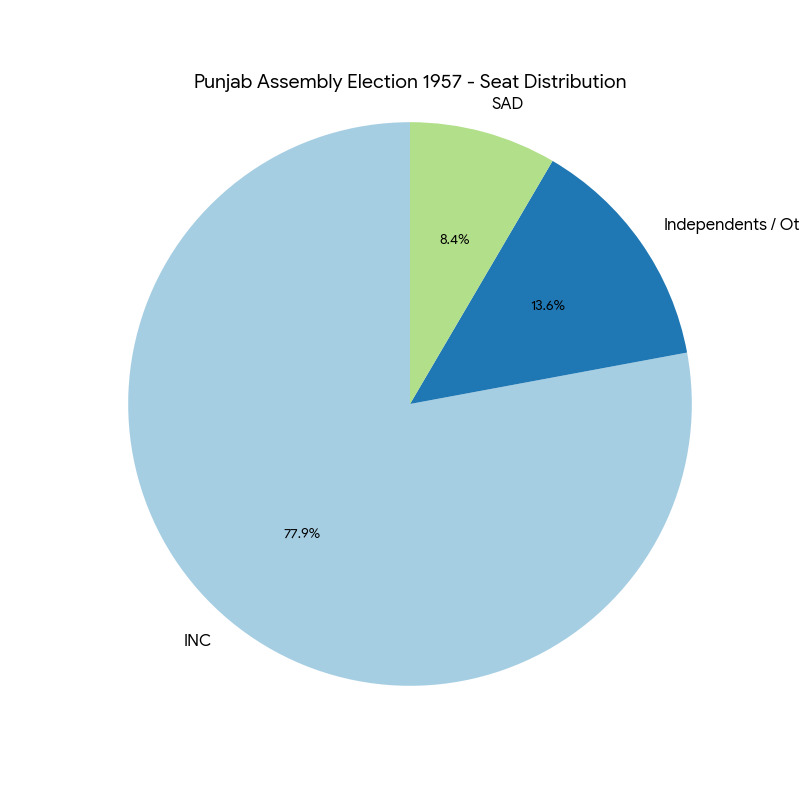
1962 Punjab Legislative Assembly Election Results
| 1962 Punjab Legislative Assembly Election Results | |||
|---|---|---|---|
| Sr. No. | Short Name | Full Name | Seats |
| 1 | INC | Indian National Congress | 90 |
| 2 | Shiromani Akali Dal | Shiromani Akali Dal | 16 |
| 3 | CPI | Communist Party Of India | 12 |
| 4 | BJS | Bharatiya Jana Sangh | 9 |
| 5 | RPI | Republican Party of India | 5 |
| 6 | Independents & Others | Independents & Others | 22 |
| Total | 154 | ||
The Indian National Congress (INC) again formed the government with 90 seats, but its tally fell from 120 in 1957 — a sign of emerging opposition forces.
Partap Singh Kairon returned as Chief Minister, continuing his policies of modern agriculture, Green Revolution groundwork, and infrastructure growth.
The Shiromani Akali Dal (Sant Fateh Singh faction) emerged stronger with 16 seats, reflecting growing Sikh political assertion.
The Communist Party of India (CPI) also increased its footprint (12 seats), especially in industrial towns and farmer movements.
The Bharatiya Jana Sangh (BJS), contesting in Hindu-majority regions, won 9 seats — an early sign of its influence in Punjab-Haryana areas.
Independents (22 seats) still played a significant role, but their relevance was gradually declining as organized parties consolidated.

1967 Punjab Legislative Assembly Election Results
| 1967 Punjab Legislative Assembly Election Results | |||
|---|---|---|---|
| Sr. No. | Short Name | Full Name | Seats |
| 1 | INC | Indian National Congress | 48 |
| 2 | Akali Dal | Akali Dal | 24 |
| 3 | BJS | Bharatiya Jana Sangh | 9 |
| 4 | CPI | Communist Party Of India | 5 |
| 5 | Independents & Others | Independents & Others | 18 |
| Total | 104 | ||
For the first time, the Congress fell below majority with 48 seats (needed 53).
The Akali Dal (Sant Fateh Singh faction) with 24 seats, allied with Jana Sangh, CPI, CPI(M), and Independents, to form a non-Congress coalition government.
Gurnam Singh (Akali Dal) became the first non-Congress Chief Minister of Punjab.
However, the coalition was fragile due to ideological differences (Sikh-centered Akali Dal, right-wing Jana Sangh, leftist CPI/CPI(M)).
The government collapsed within a year, leading to political instability and frequent changes in leadership.

1969 Punjab Legislative Assembly Election Results
| 1969 Punjab Legislative Assembly Election Results | |||
|---|---|---|---|
| Sr. No. | Short Name | Full Name | Seats |
| 1 | Akali Dal | Akali Dal | 43 |
| 2 | INC | Indian National Congress | 38 |
| 3 | Independents & Others | Independents & Others | 23 |
| Total | 104 | ||
The Akali Dal (Sant Fateh Singh faction) became the largest party with 43 seats, but still short of the majority mark (53).
The Indian National Congress (INC) got 38 seats, losing its earlier dominance.
Bharatiya Jana Sangh (BJS) maintained its influence in Hindu-dominated towns with 8 seats.
The Left parties (CPI & CPI(M)) declined further, winning just 1 seat each.
Independents (13 seats) were crucial in forming the government.
With support from Jana Sangh and Independents, Gurnam Singh again became the Chief Minister, heading an Akali Dal-led coalition.
This government too was unstable due to frequent clashes within the coalition, setting a trend of political volatility in Punjab during the late 1960s and 1970s.

1972 Punjab Legislative Assembly Election Results
| 1972 Punjab Legislative Assembly Election Results | |||
|---|---|---|---|
| Sr. No. | Short Name | Full Name | Seats |
| 1 | INC | Indian National Congress | 66 |
| 2 | Shiromani Akali Dal | Shiromani Akali Dal | 24 |
| 3 | BJS | Bharatiya Jana Sangh | 8 |
| 4 | Independents & Others | Independents & Others | 11 |
| Total | 109 | ||
The Congress (INC) scored a decisive victory with 66 seats, comfortably crossing the majority mark (53).
Giani Zail Singh became the Chief Minister. He later went on to become the President of India (1982–87).
The Akali Dal, which had been gaining momentum earlier, slipped back to 24 seats, reflecting a decline in its influence at that stage.
The Bharatiya Jana Sangh (BJS) remained steady with 8 seats, keeping its relevance in Punjab’s Hindu belt.
Interestingly, the CPI bounced back with 10 seats, gaining traction among farmers and workers during this period.
This election restored Congress dominance in Punjab politics after a brief period of Akali-led governments in 1967 and 1969.
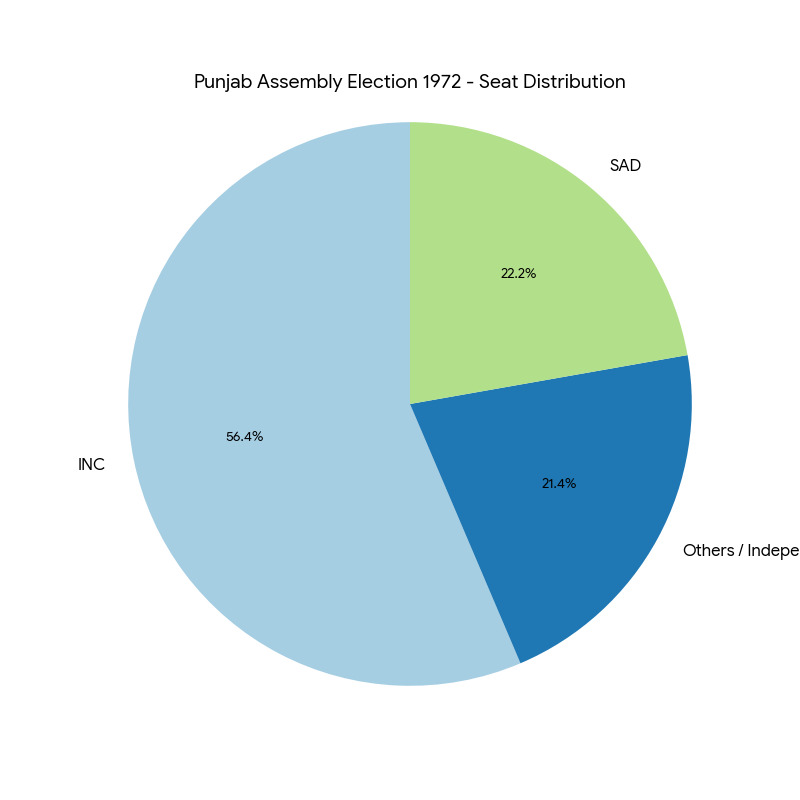
1977 Punjab Legislative Assembly Election Results
| 1977 Punjab Legislative Assembly Election Results | |||
|---|---|---|---|
| Sr. No. | Short Name | Full Name | Seats |
| 1 | Shiromani Akali Dal | Shiromani Akali Dal | 58 |
| 2 | Janata Party | Janata Party | 25 |
| 3 | INC | Indian National Congress | 17 |
| 4 | Independents & Others | Independents & Others | 17 |
| Total | 117 | ||
Riding on the anti-Emergency wave, the Shiromani Akali Dal (SAD) won 58 seats and became the single largest party.
With support from the Janata Party (25 seats) and Left parties, Parkash Singh Badal formed the government and became the Chief Minister.
The Congress (INC) was decimated, reduced to just 17 seats, marking one of its worst performances in Punjab.
Both CPI (7 seats) and CPI(M) (8 seats) had a respectable combined influence, especially in rural and working-class belts.
This election firmly established the Akali Dal–Congress rivalry as the central theme of Punjab politics.
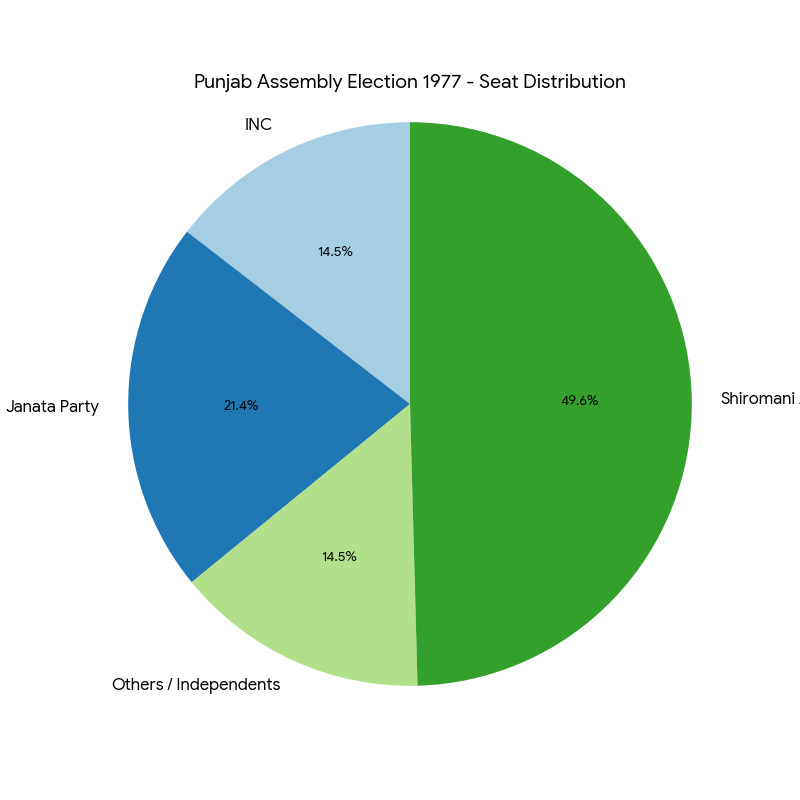
1980 Punjab Legislative Assembly Election Results
| 1980 Punjab Legislative Assembly Election Results | |||
|---|---|---|---|
| Sr. No. | Short Name | Full Name | Seats |
| 1 | INC | Indian National Congress | 63 |
| 2 | SAD | Shiromani Akali Dal | 37 |
| 3 | Independents & Others | Independents & Others | 17 |
| Total | 117 | ||
The Congress (INC), led by Darbara Singh, secured 63 seats, crossing the majority mark and regaining power in Punjab.
The Shiromani Akali Dal (SAD) won 37 seats, remaining the main opposition force but weakened compared to 1977.
The Left parties (CPI with 9 and CPI(M) with 6) together held a notable 15 seats, showing their strength among workers and farmers.
Darbara Singh was sworn in as Chief Minister.
This election was crucial because it came just before the emergence of militancy in Punjab (1980s). The Congress rule faced increasing challenges from the growing Akali–Center tensions and rising Sikh political assertiveness.
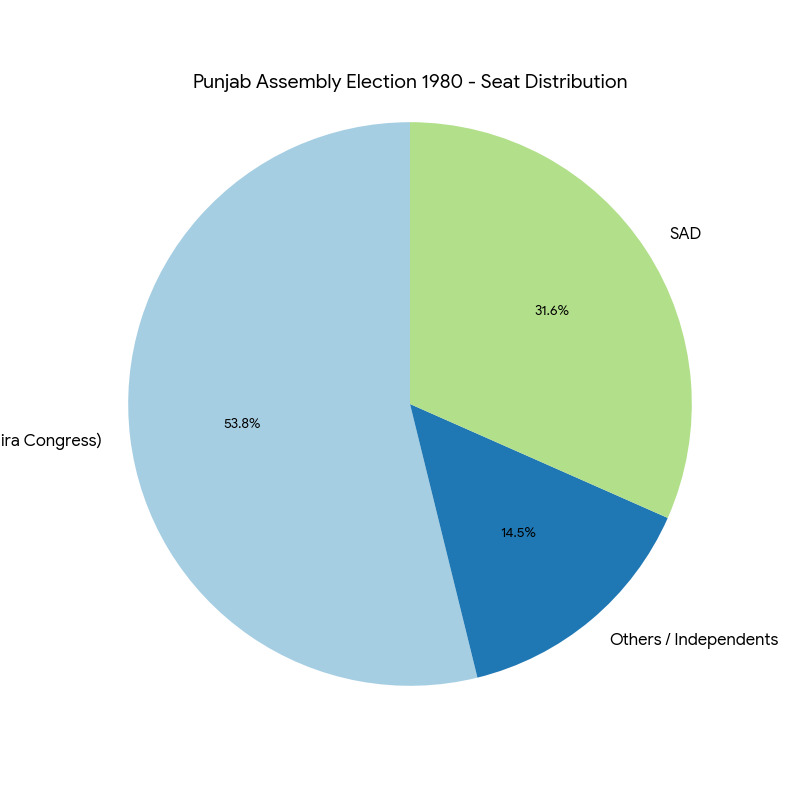
1985 Punjab Legislative Assembly Election Results
| 1985 Punjab Legislative Assembly Election Results | |||
|---|---|---|---|
| Sr. No. | Short Name | Full Name | Seats |
| 1 | SAD | Shiromani Akali Dal | 73 |
| 2 | INC | Indian National Congress | 32 |
| 3 | Independents & Others | Independents & Others | 12 |
| Total | 117 | ||
The Shiromani Akali Dal (SAD) secured a landslide victory with 73 seats, forming a stable government after years of turmoil.
Surjit Singh Barnala became the Chief Minister.
The Congress (INC) was reduced to 32 seats, as Sikh voters largely shifted to the Akali Dal following the aftermath of Operation Blue Star and perceived Congress hostility toward Sikh sentiments.
Left parties (CPI – 6, CPI(M) – 1) had a minor presence.
The election was conducted in a tense environment but was crucial in restoring democratic governance in Punjab.
However, militancy and insurgency continued to grow in the late 1980s, making governance extremely difficult despite the Akali victory.
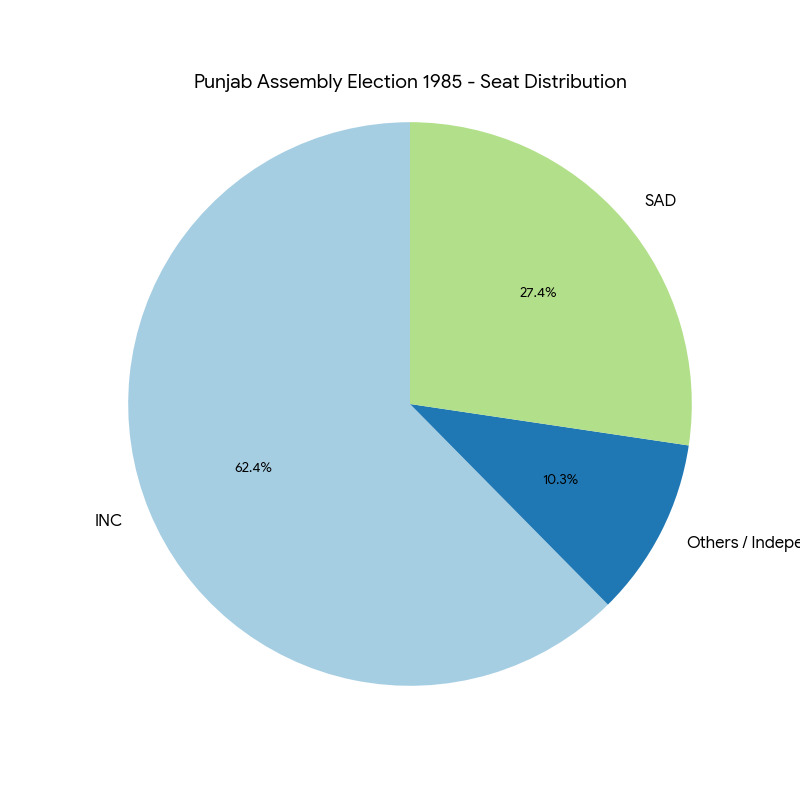
1992 Punjab Legislative Assembly Election Results
| 1992 Punjab Legislative Assembly Election Results | |||
|---|---|---|---|
| Sr. No. | Short Name | Full Name | Seats |
| 1 | INC | Indian National Congress | 87 |
| 2 | BSP | Bahujan Samaj Party | 9 |
| 3 | Independents & Others | Independents & Others | 21 |
| Total | 117 | ||
With the Akali Dal boycotting, the Indian National Congress (INC) under Beant Singh swept the elections with 87 seats, forming the government.
The Bahujan Samaj Party (BSP) surprised many by winning 9 seats, becoming the main opposition in the assembly.
The BJP managed only 3 seats, as urban Hindu voters largely stayed away from polling booths.
Left parties (CPI – 4) had some representation but limited influence.
This election is often described as a “one-sided contest” because the Akali Dal’s absence allowed Congress to dominate.
Despite Congress’s victory, militancy continued, and CM Beant Singh was later assassinated in 1995 by militants.
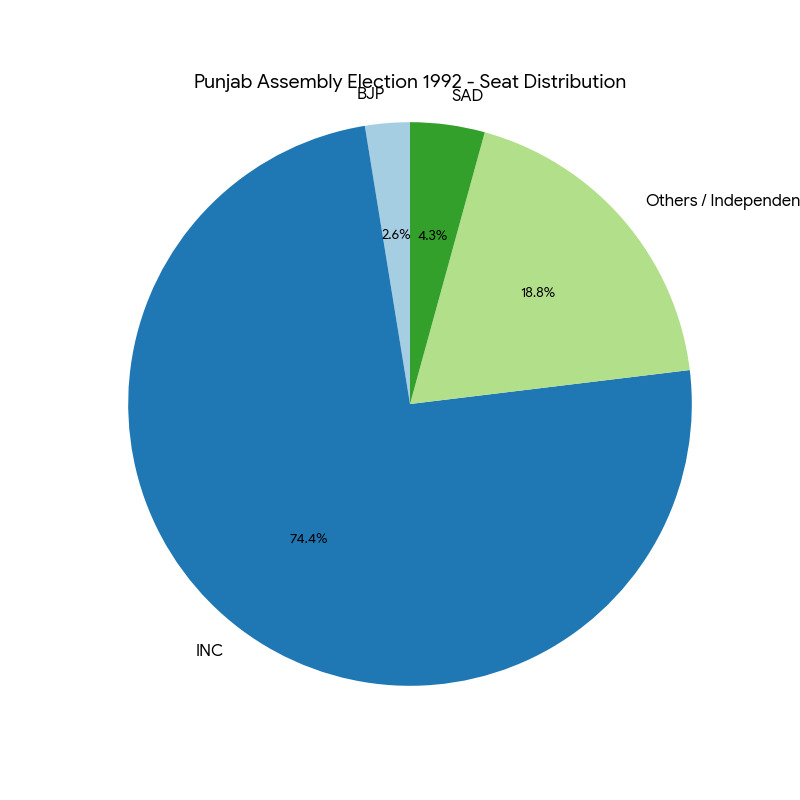
1997 Punjab Legislative Assembly Election Results
| 1997 Punjab Legislative Assembly Election Results | |||
|---|---|---|---|
| Sr. No. | Short Name | Full Name | Seats |
| 1 | SAD | Shiromani Akali Dal | 75 |
| 2 | BJP | Bharatiya Janata Party | 18 |
| 3 | INC | Indian National Congress | 14 |
| 4 | Independents & Others | Independents & Others | 10 |
| Total | 117 | ||
The SAD-BJP alliance registered a landslide victory, winning 93 seats combined (SAD 75 + BJP 18).
Parkash Singh Badal became the Chief Minister, marking his second term in office.
The Congress (INC), which had swept the boycotted 1992 polls, collapsed to just 14 seats.
The BSP, which was the second-largest party in 1992, fell to only 1 seat.
This election marked the return of competitive multi-party democracy in Punjab after the boycott of 1992.
It also stabilized Punjab politics after years of militancy and low-turnout elections.
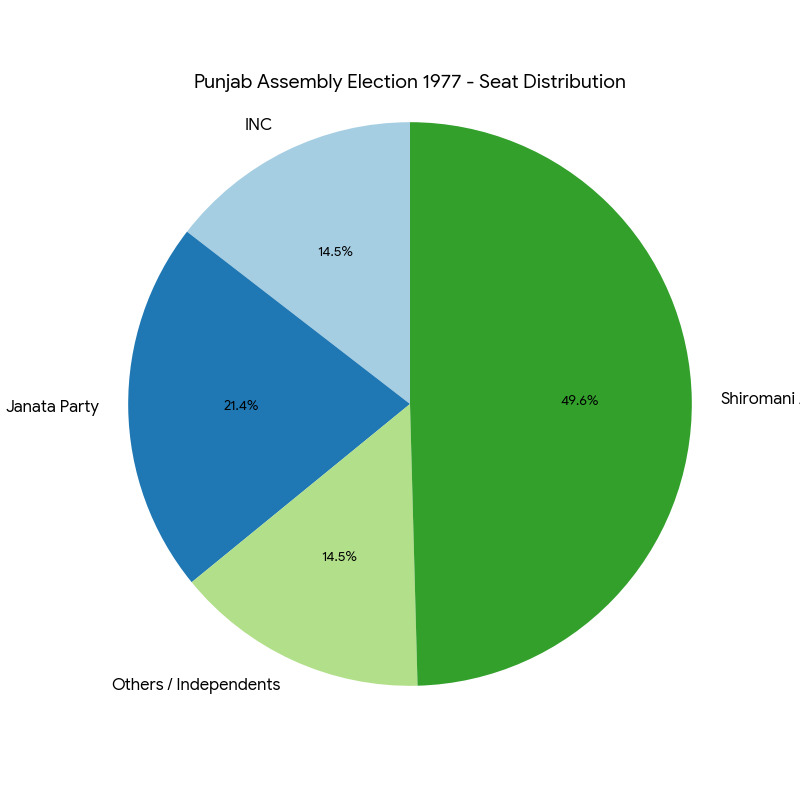
2002 Punjab Legislative Assembly Election Results
| 2002 Punjab Legislative Assembly Election Results | |||
|---|---|---|---|
| Sr. No. | Short Name | Full Name | Seats |
| 1 | INC | Indian National Congress | 62 |
| 2 | SAD | Shiromani Akali Dal | 41 |
| 3 | BJP | Bharatiya Janata Party | 3 |
| 4 | Independents & Others | Independents & Others | 11 |
| Total | 117 | ||
The Congress (INC), led by Captain Amarinder Singh, won 62 seats, just above the majority mark, and returned to power after 10 years (last time in 1992).
SAD was reduced to 41 seats, facing strong anti-incumbency.
The BJP, allied with SAD, managed only 3 seats, showing its limited rural appeal.
Left parties and independents had little influence.
Captain Amarinder Singh became Chief Minister, focusing on farmer debt relief, governance reforms, and tackling drug abuse (though these issues persisted).
This election marked the revival of Congress dominance in Punjab after the Akali-BJP sweep of 1997.
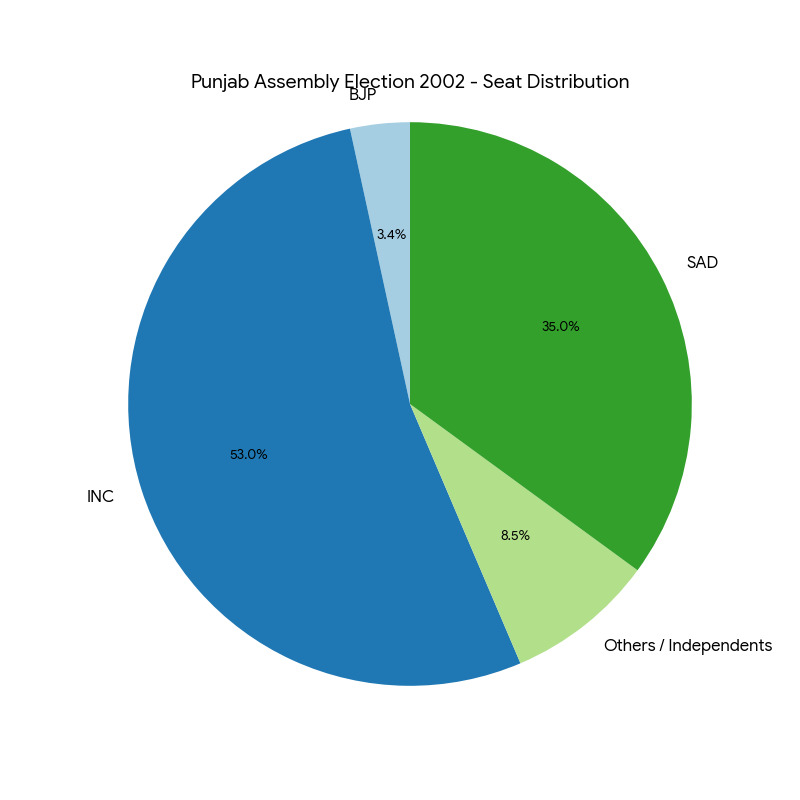
2007 Punjab Legislative Assembly Election Results
| 2007 Punjab Legislative Assembly Election Results | |||
|---|---|---|---|
| Sr. No. | Short Name | Full Name | Seats |
| 1 | SAD | Shiromani Akali Dal | 48 |
| 2 | INC | Indian National Congress | 44 |
| 3 | BJP | Bharatiya Janata Party | 19 |
| 4 | Independents & Others | Independents & Others | 6 |
| Total | 117 | ||
The SAD-BJP alliance together secured 67 seats (SAD 48 + BJP 19), comfortably crossing the majority mark of 59.
Parkash Singh Badal returned as Chief Minister for a record fourth term.
The Congress (INC) put up a strong fight, winning 44 seats, but failed to retain power.
The BJP made significant urban gains, becoming an influential partner in government.
Smaller parties like CPI (2) and Independents (4) played only a minor role.
This election reinforced the alternating pattern of power between Congress and the SAD-BJP alliance in Punjab politics.

2012 Punjab Legislative Assembly Election Results
| 2012 Punjab Legislative Assembly Election Results | |||
|---|---|---|---|
| Sr. No. | Short Name | Full Name | Seats |
| 1 | SAD | Shiromani Akali Dal | 56 |
| 2 | BJP | Bharatiya Janata Party | 12 |
| 3 | INC | Indian National Congress | 46 |
| 4 | Independents & Others | Independents & Others | 3 |
| Total | 117 | ||
The SAD-BJP alliance together won 68 seats (SAD 56 + BJP 12), crossing the majority mark and forming government again.
This was the first time since the reorganization of Punjab (1966) that a ruling party/alliance was re-elected for a second consecutive term.
Parkash Singh Badal became Chief Minister for a fifth time, a record in Punjab politics.
The Congress (INC) won 46 seats, a respectable performance but not enough to unseat the government.
Manpreet Badal’s PPP, which had split from SAD and was seen as a new alternative, failed badly and won no seats.
This victory was largely attributed to welfare schemes, improved roads, urban development, and subsidies provided during SAD-BJP’s previous term.

2017 Punjab Legislative Assembly Election Results
| 2017 Punjab Legislative Assembly Election Results | |||
|---|---|---|---|
| Sr. No. | Short Name | Full Name | Seats |
| 1 | INC | Indian National Congress | 77 |
| 2 | AAP | Aam Aadmi Party | 20 |
| 3 | SAD | Shiromani Akali Dal | 15 |
| 4 | Independents & Others | Independents & Others | 5 |
| Total | 117 | ||
The Congress (INC) won a landslide victory with 77 seats, comfortably above the majority mark of 59.
Captain Amarinder Singh became CM for the second time, after his earlier term (2002–07).
The Aam Aadmi Party (AAP) contested its first Punjab Assembly election and won 20 seats, becoming the main opposition.
The SAD-BJP alliance suffered a historic defeat, winning only 18 seats combined (SAD 15 + BJP 3).
This election ended 10 years of Akali-BJP rule, as people sought change due to the drug problem, corruption charges, and farmer issues.
The result also showed the rise of AAP in Punjab, signaling a future shift in state politics.
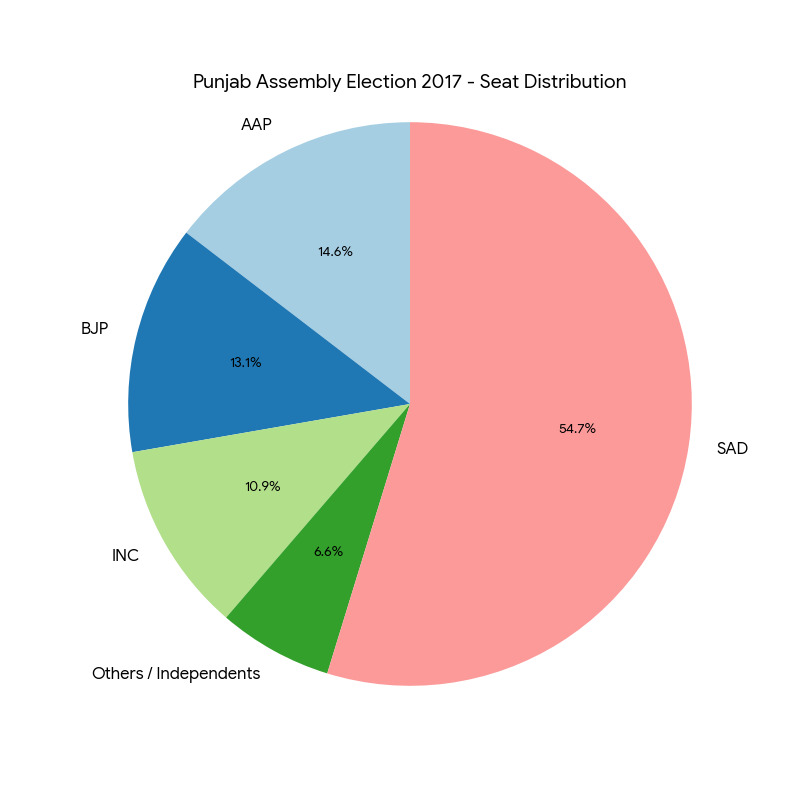
2022 Punjab Legislative Assembly Election Results
| 2022 Punjab Legislative Assembly Election Results | |||
|---|---|---|---|
| Sr. No. | Short Name | Full Name | Seats |
| 1 | AAP | Aam Aadmi Party | 92 |
| 2 | INC | Indian National Congress | 18 |
| 3 | Independents & Others | Independents & Others | 7 |
| Total | 117 | ||
The Aam Aadmi Party (AAP) won an unprecedented 92 seats, a clear three-fourths majority, the biggest ever victory in Punjab Assembly history.
Bhagwant Mann, a popular comedian-turned-politician, was sworn in as Chief Minister.
The Congress, which had 77 seats in 2017, collapsed to just 18 seats, due to leadership changes (Amarinder Singh’s exit, Channi’s late elevation) and internal infighting.
The SAD was reduced to 3 seats, its worst-ever performance, while its ally BSP managed 1 seat.
The BJP, despite forming alliances after breaking from SAD, secured only 2 seats.
AAP’s victory ended the decades-long dominance of Congress and SAD, reshaping Punjab’s politics.
